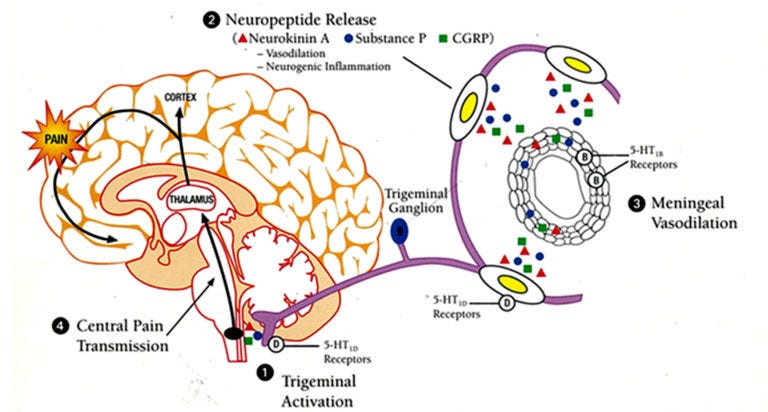Butterbur and Feverfew for Migraine: What the Science Really Says
a research-backed guide to two of the most studied herbs for migraine prevention—how they work, what the studies show, and why their synergy still remains a mystery.
It starts as a flicker—light bending at strange angles, a shimmer at the edge of vision.
Then comes the pressure. The nausea. The sound of your own heartbeat thudding louder than the world.
For those who live with migraines, time becomes unpredictable. Plans fracture. Light hurts. Even words, once so easy, feel distant or lost. Days slip through fingers, replaced by darkness, silence, and the ache of needing to explain—again—that this isn’t just a headache.
Migraines don’t just cause pain—they reshape lives.
And while pharmaceuticals help many, they don’t help all. Some come with side effects that compound the suffering. Others fall short entirely.
That’s where plants come in.
Not as miracle cures, but as allies—humble, potent, and time-tested.
When it comes to plant-based migraine support, two herbs stand out for their combination of clinical promise and deep traditional use:
Petasites hybridus, commonly known as Butterbur
Tanacetum parthenium, better known as Feverfew
These aren’t just trendy TikTok tinctures.
They’re rooted in the herbal traditions of Europe, where they’ve been used for centuries to calm the nervous system, balance circulation, and relieve pain—long before the words migraine, neuropeptide, or CGRP entered the medical lexicon.
And now, decades of research have begun to affirm what herbalists have known for generations: these herbs interact with the exact biological pathways involved in migraines.
We’re talking about:
Neurogenic inflammation (via CGRP, substance P, nitric oxide)
Serotonin dysregulation (a known player in migraine pathogenesis)
Vasodilation and vasospasm (especially in migraines with aura)
Ion channel disruption and calcium signaling, contributing to cortical hyperexcitability
Their actions aren’t “relaxing” in a vague, feel-good way—they are targeted, physiological responses to the storm inside the migraine brain.
But which herb is more effective?
Which is better tolerated over time?
And—perhaps most importantly—why haven’t they been studied together, when tradition suggests synergy and modern science increasingly supports it?
Let’s dig into the evidence and find out.

A Brief Look at the Science of Migraine
Before we talk herbs, we have to talk about what’s actually happening in the body during a migraine—especially one that begins with an aura.
Migraine with aura isn’t just a headache with a light show. It’s a neurovascular event, often set off by something called cortical spreading depression: a slow wave of electrical disruption that moves across the brain like a shadow. This wave temporarily alters how parts of the brain function—often leading to strange visual disturbances, tingling in the limbs, or difficulty speaking. The body senses something is off before the pain even starts.
That’s when the storm rolls in.
What follows is a release of potent signaling chemicals—CGRP (calcitonin gene-related peptide), nitric oxide, substance P, and other pro-inflammatory players. Blood vessels dilate. Nerves become hypersensitive. Pain centers light up like fireworks. It’s not dramatic to say the body is in full alert mode.
Migraine Pathogenesis
And here’s the kicker:
Many migraine sufferers are genetically primed for this.
Researchers have linked certain mutations—like CACNA1A or ATP1A2—to changes in ion channels, which regulate how nerves fire.
Others may have mitochondrial dysfunction, poor detox capacity, or an overreaction to everyday triggers like light, food additives, hormones, or disrupted sleep. It’s not “just stress”—though stress can certainly strike the match.
So, when we talk about herbs, we’re not talking about vague “relaxation” or “natural” solutions.
We’re talking about plants that have the potential to modulate:
Neuroinflammation
Serotonin signaling
Vascular tone
CGRP expression
And even the delicate dance of calcium ions across nerve cell membranes
That’s why the research on Butterbur and Feverfew is so compelling—they act on some of these exact pathways.
We’re not just treating pain. We’re working to shift the terrain.

The rest of this article includes a deeper exploration of Butterbur and Feverfew—two herbs rooted in tradition and increasingly supported by science. We’ll explore:
How each herb works on the migraine brain
The evidence from modern clinical trials
Their mechanisms of action and biological targets
Safety considerations and why sourcing matters
The surprising gap in research around using them together
This part of the article is available exclusively to paid subscribers of The Buffalo Herbalist. If you’re enjoying this kind of thoughtful, research-backed herbal writing, I invite you to consider upgrading your subscription.
Your support helps me continue creating herbal content that respects both the wisdom of tradition and the rigor of science—without dumbing it down or dressing it up.
If starting a new subscription isn’t in the cards for you right now, but you’d still like to support my work, you can do so by ‘buying me a coffee’. Nothing is expected, everything deeply appreciated.
Keep reading with a 7-day free trial
Subscribe to The Buffalo Herbalist to keep reading this post and get 7 days of free access to the full post archives.




